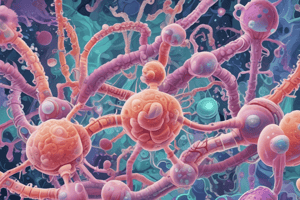Podcast
Questions and Answers
What type of specimens are used for diagnosing Enterobacteriaceae?
What type of specimens are used for diagnosing Enterobacteriaceae?
- Urine, blood, pus, spinal fluid, sputum (correct)
- Saliva and hair samples
- Only blood and urine
- Only sputum and spinal fluid
What is indicated by the presence of large capsules in smears?
What is indicated by the presence of large capsules in smears?
- Streptococcus
- Presence of viruses
- Klebsiella species (correct)
- Staphylococcus
On what type of media are specimens plated for culture?
On what type of media are specimens plated for culture?
- Blood agar and differential media (correct)
- Chocolate agar
- Selective media only
- Blood agar only
What do multiplex NAATs detect in specimens?
What do multiplex NAATs detect in specimens?
What makes antibiotic susceptibility testing essential in treatment?
What makes antibiotic susceptibility testing essential in treatment?
What is a common preventive measure for traveler's diarrhea?
What is a common preventive measure for traveler's diarrhea?
What is the major habitat of E. coli in the body?
What is the major habitat of E. coli in the body?
How are enteric bacteria commonly transmitted within hospitals?
How are enteric bacteria commonly transmitted within hospitals?
What specific antibiotics are suggested for brief treatment of traveler's diarrhea?
What specific antibiotics are suggested for brief treatment of traveler's diarrhea?
What are the primary control measures in hospitals for multidrug-resistant enteric bacteria?
What are the primary control measures in hospitals for multidrug-resistant enteric bacteria?
Flashcards are hidden until you start studying
Study Notes
Enteric Gram-Negative Rods Enterobacteriaceae
Diagnostic Laboratory Tests
- Specimens include urine, blood, pus, spinal fluid, sputum, or other material depending on the disease location.
- Morphologically, Enterobacteriaceae resemble each other, with large capsules suggesting Klebsiella species.
- Specimens are plated on both blood agar and differential media for rapid preliminary identification.
- Nucleic Acid Amplification Tests (NAATs) detect Enterobacteriaceae in specimens such as positive blood cultures, cerebrospinal fluid, respiratory specimens, and stool, and may also detect resistance markers.
Immunity
- Specific antibodies develop in systemic infections, but it is unclear if significant immunity to the organisms follows.
Treatment
- No single specific therapy is available for Enterobacteriaceae.
- Sulfonamides, ampicillin, cephalosporins, fluoroquinolones, and aminoglycosides have marked antibacterial effects, but susceptibility varies and laboratory tests are essential.
- Multiple drug resistance is common and controlled by transmissible plasmids.
- Treatment of gram-negative bacteremia and impending septic shock requires rapid institution of antimicrobial therapy and restoration of fluid and electrolyte balance.
Epidemiology, Prevention, and Control
- Enteric bacteria establish themselves in the normal intestinal tract within a few days after birth and form a main portion of the normal aerobic microbial flora.
- Control measures are not feasible for normal endogenous microbiota.
- Enteropathogenic E.coli serotypes should be controlled like salmonellae.
- Enterics are a major problem in hospital infection, particularly in debilitated patients.
- Control depends on handwashing, rigorous asepsis, sterilization of equipment, disinfection, and strict precautions in keeping the urinary tract sterile.
The Shigellae
- The natural habitat of shigellae is limited to the intestinal tracts of humans and other primates.
Studying That Suits You
Use AI to generate personalized quizzes and flashcards to suit your learning preferences.




